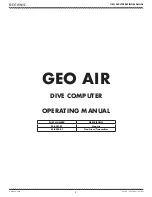
ML0030 August 2009 Copyright 2009 Bitronics, LLC
−
4
−
aid in wiring the units into substation or control panels. A wiring diagram is also provided in
the form of a decal on the side of the meter. Grounding of PT & CT signals per ANSI/IEEE
C57.13.3-1983 is recommended.
Power is applied to two #10-32 brass studs, also located on the rear cover of the
instrument. WARNING - DO NOT overtighten the nuts on the input connections, HAND
tighten with a standard nutdriver, 12 inch-pounds is recommended, MAXIMUM torque is 15
inch-pounds. Because of the solid state design, the total load required to operate the unit
is only six WATTs. It is therefore possible to power the WATT/VAR Meter with AC station
power or an auxiliary PT, provided the voltage remains above 90 volts. Units are normally
shipped configured for 115Vac, however they may be special ordered with a 230Vac or
Universal (AC/DC) supply.
2.3 Current and Potential Transformer Board (CT/PT Board)
The current and potential transformer (CT/PT) board contains secondary transformers
which provide electrical isolation for each of the signal input channels. Current from the
current terminals flows though a silver-soldered shunt of negligible resistance to assure that
the user's external CT circuit can never open-circuit, even under extreme fault conditions.
Potential voltages are carried through 10-32 studs directly to the CT/PT board to guarantee
reliable connections to the high-impedance secondary transformer circuits. The use of
transformer isolation on all input leads provides excellent isolation (1500Vac) between the
inputs and any output.
2.4 Power Supply Board (PS Board)
The power supply circuit is a conservative, conventional design. Low drop rectifiers and a
low drop-out solid state regulator minimize internal power dissipation. Filter capacitors are
operated at a fraction of their voltage and temperature ratings, and should provide years of
trouble-free service under extreme environmental conditions.
Bitronics WATT/VAR instruments provide for complete interchangeability among signal
processing and display modules. Compensation for normal variations in input circuits is
achieved by storing calibration constants in a non-volatile memory (EEPROM) which
resides on the PS board. These constants are factory-programmed to provide identical
signal gain (attenuation) in each of the six isolated signal input paths. The CT and PT
settings for scaling the display to the user's CTs and PTs are also stored in this EEPROM.
Checksums are incorporated into the EEPROM which are read periodically by the
microcontroller to check the integrity of the calibration constants and the CT and PT setting
(See section 4.3).
2.5 Analog Processing Board (AP Board)
The first function of Analog Processing board is to sample and digitize the low level AC
signals provided by the CT/PT board, and to provides a digital number to the
microcontroller (MCU) for further processing. Signal processing begins with the low level
AC signal supplied from the CT/PT board which is about one volt ac RMS for a full scale
input signal. Pure sine wave inputs or complex, distorted, periodic waveforms are handled
equally well - a major advantage when computing WATTs and VARs for unknown current
and voltage waveforms. This design frees the user from concern about errors which will
Содержание QTWIE2
Страница 4: ......
Страница 20: ...Figure 4 Typical connection diagram for 2 Element Watt Var Watt Var Meters ...






































